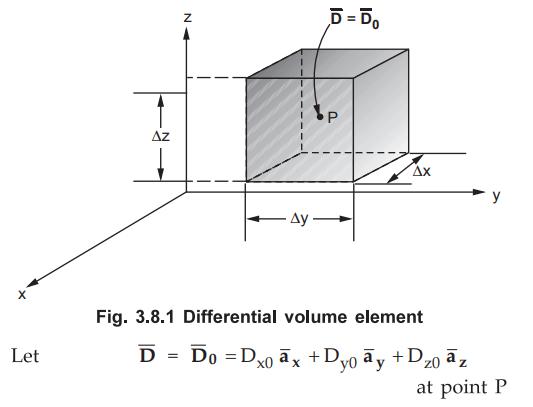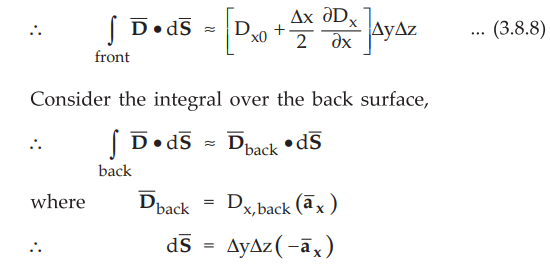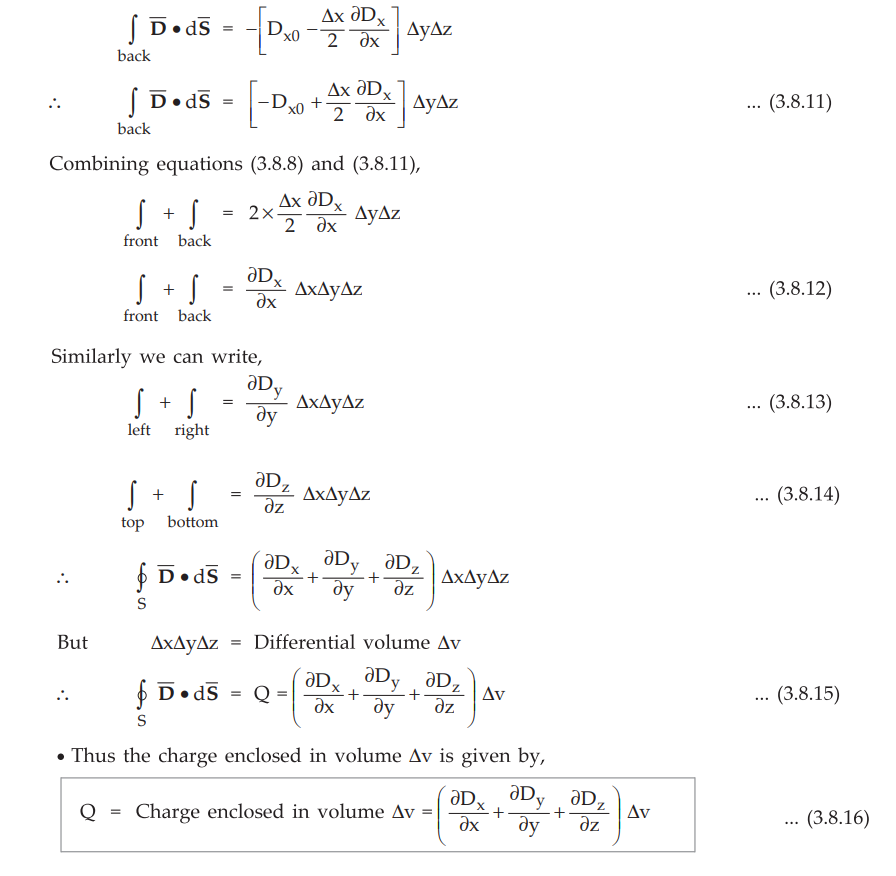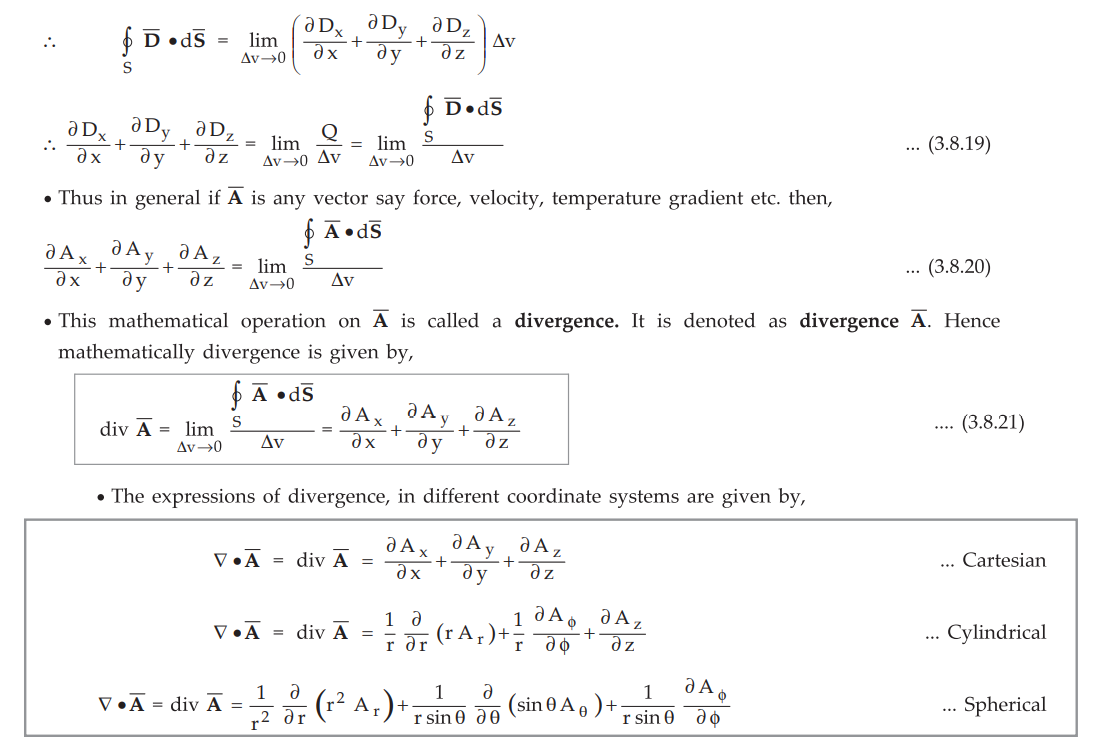Electromagnetic Theory: Unit I: (c) Gauss Law and Applications
Gauss's Law Applied to Differential Volume Element
• Consider the closed Gaussian differential surface in the form of rectangular box, which is a differential volume element. The sides of this element are Δx, Δy, and Δz.
Gauss's Law Applied to Differential Volume Element
Uptill
now we have considered the various cases n which there exists a symmetry and
component of ![]()
![]() is normal to the surface and constant everywhere on the surface. But if there
does not exist a symmetry and Gaussian surface can not be chosen such that normal
component of
is normal to the surface and constant everywhere on the surface. But if there
does not exist a symmetry and Gaussian surface can not be chosen such that normal
component of ![]() is constant or zero everywhere on the surface,
Gauss's law cannot be directly applied.
is constant or zero everywhere on the surface,
Gauss's law cannot be directly applied.
•
In such a case a differential closed Gaussian surface is considered. The closed
surface is so small that ![]() is almost constant everywhere on the surface.
Finally results can be obtained by decreasing the volume enclosed by Gaussian
surface to approach to zero.
is almost constant everywhere on the surface.
Finally results can be obtained by decreasing the volume enclosed by Gaussian
surface to approach to zero.
•
Consider a cartesian co-ordinate system and a point P in it such that the
electric flux density at P is given by,

•
Consider the closed Gaussian differential surface in the form of rectangular
box, which is a differential volume element. The sides of this element are Δx,
Δy, and Δz. The position of this element is such that the point P is at the
centre of the element and treated to be origin. Hence ![]() at P can be
denoted as
at P can be
denoted as ![]() 0. This is shown in the Fig. 3.8.1.
0. This is shown in the Fig. 3.8.1.

•
The components Dx0, Dy0 and Dz0 vary with
distance in the respective directions.
•
According to Gauss's law,

•
The total surface integral is to be evaluated over six surfaces front, back,
leftside, rightside, top and bottom.

•
Consider the front surface of the differential element. Though ![]() is
varying with distance, for small surface like front surface it can be assumed
constant.
is
varying with distance, for small surface like front surface it can be assumed
constant.

It
has been mentioned that D x, front is changing in x direction. At P,
it is Dx0 while on the front surface it will change and given by,

•
The point P is at the centre so distance of surface in x direction from P is Δx
/ 2
•
The rate of change is expressed as partial derivative as Dx varies
with y and z co-ordinates also.

Key
Point : Note that the flux is entering from back side and
leaving from front in positive x direction hence  While the surface considered from point P is in negative x direction
hence
While the surface considered from point P is in negative x direction
hence 

•
Now Dx,back is changing with x. At P it is Dx0 while on
the back side it will be different and can be obtained as,

•
The negative sign is used as the surface is in negative direction of x from P.
Substituting in (3.8.9) we get,

•
This result leads to the concept of divergence.
1. Divergence
•
Applying Gauss's law to the differential volume element, we have obtained the
relation,
Q
= (∂Dx / ∂x + ∂Dy / ∂y + ∂Dz / ∂z) Δv
•
This is the charge enclosed in the volume Δv.

•
To apply Gauss's law, we have assumed a differential volume element as the
Gaussian surface, over which ![]() is constant. Hence equations (3.8.17) and
(3.8.18) can be equated in limiting case as Δv → 0.
is constant. Hence equations (3.8.17) and
(3.8.18) can be equated in limiting case as Δv → 0.

•
The relations are frequently required in the engineering electromagnetics.
Review Question
1. Explain the Gauss's law as applied to the differential volume
element. Hence define divergence of a vector field.
Electromagnetic Theory: Unit I: (c) Gauss Law and Applications : Tag: : - Gauss's Law Applied to Differential Volume Element
Related Topics
Related Subjects
Electromagnetic Theory
EE3301 3rd Semester EEE Dept | 2021 Regulation | 3rd Semester EEE Dept 2021 Regulation
